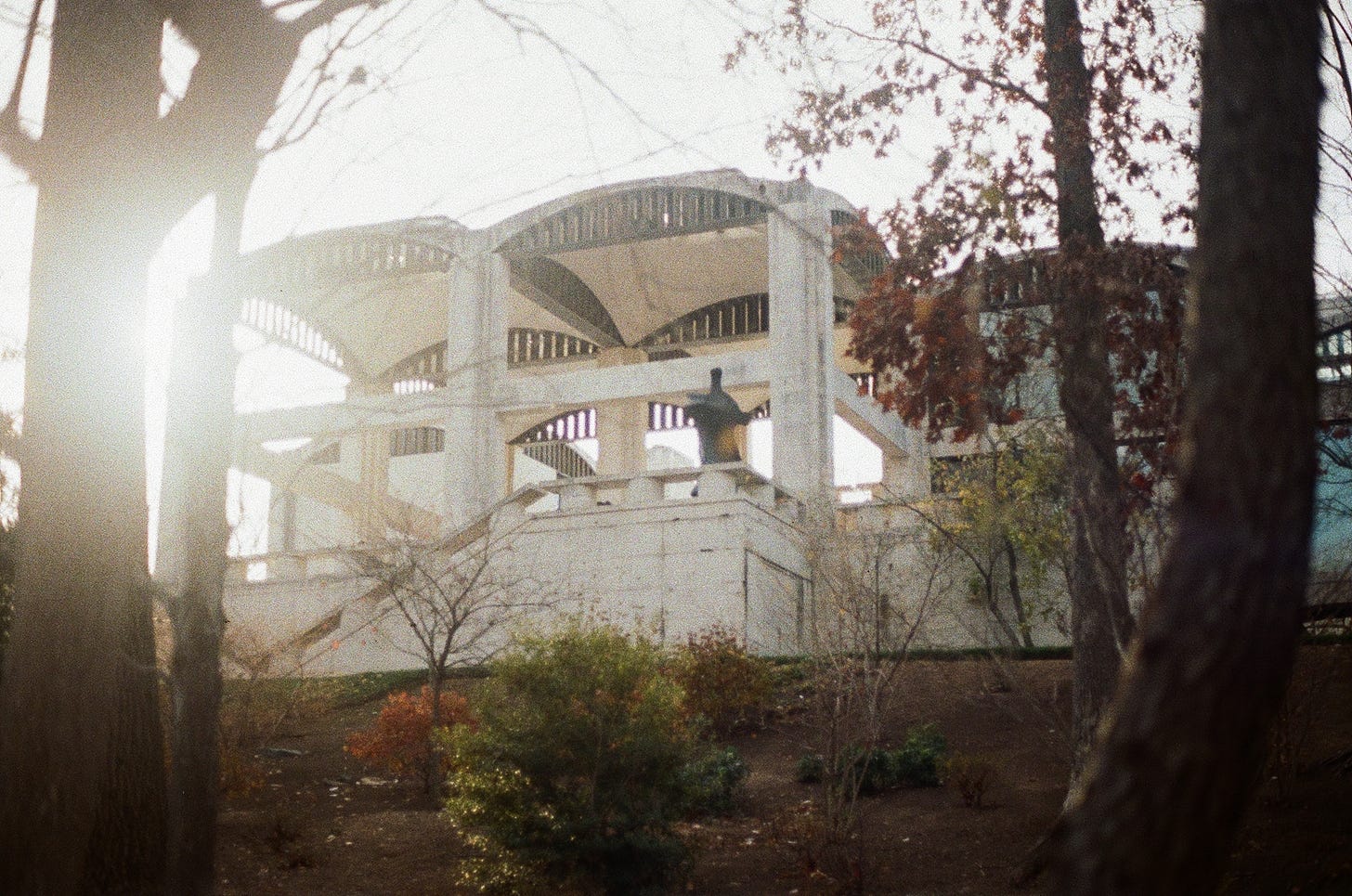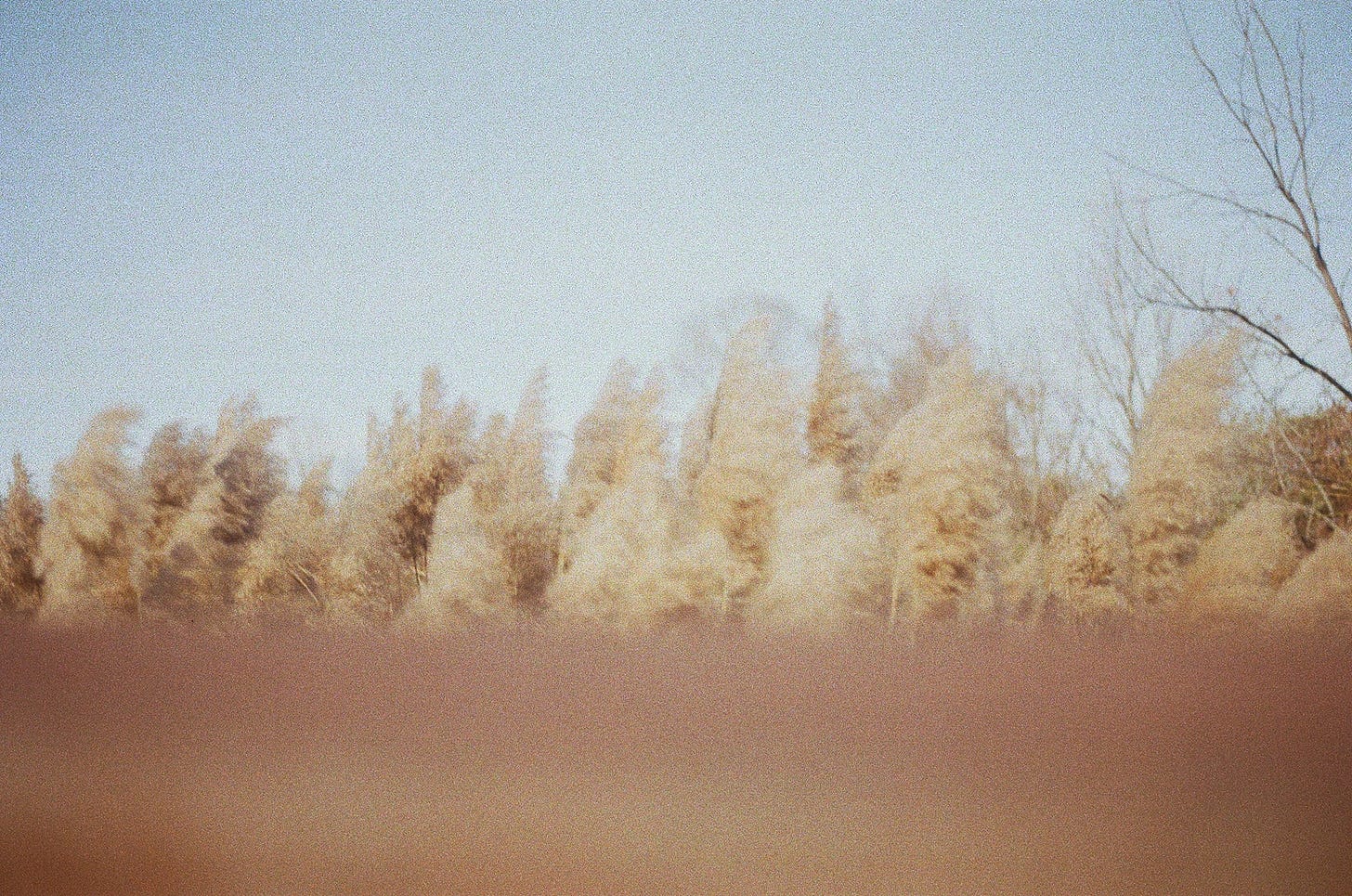
Fiber artist Iana Dobreva punches sewing pins into the edges of a cardboard box, lining every side. She then takes yarn and wraps the entire box, warping it, in looming terms, to begin weaving in three dimensions. She’s making a backpack. In her video, she says, “If you can warp it, you can weave it.“
I stopped scrolling and let the words echo.
I wrote it down on a sticky note and stuck it onto my computer, so every time I opened it, I would be reminded.
I saw the video of her multi-part series a few weeks after starting a newsletter, where I write about artists based in the DC, Maryland, Virginia area, called warp_dmv. In the initial post, I talk about why I called it warp in a maybe over-extended metaphor.
Warp refers to the foundational threads that begin any weaving. The taunt vertical threads are the skeleton that the horizontal weft thread passes over and under.
Like the warp, arts and culture creators, workers, preservers, and lovers are the foundation that strengthens every community. I’m interested in the warp as a tool and the warp as an already existing structure. The arts are a warp and exist in a warp.
Warp typically, and definitionally, has a negative connotation. Warp: “disapproving: to cause (a person's opinions, thoughts, etc.) to be changed in a way that is wrong or unnatural.”
I counter that many of the systems we are forced to navigate are wrong and unnatural - systems that prioritize profit over people, harm over care, disregard over effort. For example, the arts are foundational to lively, thriving communities. Creative expression is a human necessity and a human right. And yet, investment in arts education, local creatives, and their impact, is routinely undervalued.
Art and the communities it can foster, distort these unnatural systems, twist their intended effects, and change outcomes. Warp is a foundation for alternating paths.
So you can see why my new guiding principle, “If you can warp it, you can weave it,” resonated so intensely.
Recently, I wrote an article for the local newsletter 730DC on why arts coverage matters. The conversations I have had, on and off the record, affirm that necessary art is being made right now, and little of it is being formally recorded. Recording by newspapers, for example, means that artists are recognized and valued in their lifetime, and it also means that, because newspapers are archived, these artists can be found in the future.
While I focus on the arts, I am also frightened by the loss of local coverage. Even the newspaper where I started freelancing has been absorbed by a regional publisher and now runs on a skeleton crew. The less local coverage there is, the less history is being recorded. The click-driven, fiery, and consumptive machine of capitalism craves money, excretes garbage, and expects us to want more. What will we reference in the future about our lives, our families, our neighbors? How will we learn about strangers who we want to better understand in the context of their histories? Can we trust Meta to hold each story, to contextualize, to care?
Newspapers have been, and are, flawed. Communities have always worked to fill the gaps left by bias, space limitation, or financial priorities. Even so, this present reality of the newspaper is disturbing. I’ve told multiple people that what’s happening right now is like the burning of the Library of Alexandria, except the library doesn’t exist yet, but the fire does. Social media is being treated as a record instead of an ephemera - it’s as much a record as any receipt that ends up crumbled, stained, and eventually trashed.
I could go on — how the loss of local coverage means the loss of local connection, further displacing us from our own neighbors. Silos are now determined by algorithms shaping what and who we care about. And that maybe loneliness, political divisiveness, and a crusade against empathy could all be connected to a greater loss in seeing, knowing, and understanding the people immediately around us - the newspaper being one of many ways we could connect. But by the time I was born, this version of the newspaper was already declining as the internet rushed in.
There is so much about the internet I love and have benefited from. I’ve been blogging on and off since middle school. I had an overall wholesome time online, learning about crafts, reading insightful and silly blogs, finding new music and movies and images that would inspire my art practice, and still do.
I’m lucky to have had this overall positive experience, and felt that the internet was just another version of a playground. From the early days of Polly Pocket online and Barbie hair salons (don’t forget Baby Krissy!) to Blogger and tumblr where I first experienced curation - developing a particular vibe based on a collection of images, videos, gifs, and text posts. Can I have tumblr-local that comes with a monthly print edition that’s archived in the local library? Maybe that’s what warp_dmv is building to; maybe it’s just a blog and will never be bigger, but it’s something I can do right now.
What has been so shocking about starting this newsletter is the response. I’ve been emailed press releases, invited to exhibition openings and previews, and asked to write about shows and artist talks — for a newsletter with fewer than 100 subscribers (so far 👀 ). I knew there was a need, and I knew I had a bare minimum level of skill to help, but I didn’t expect this.
With it has come an internal pressure to do everything perfectly (impossible). I am so concerned about unintentionally harming a community I care so deeply for: either by writing something incorrect or not covering enough. Some coverage is happening, but my writing could be the only writing outside of the artist, organization, or exhibition space’s writing. My opinion or coverage might be the only coverage. That is terrifying. It used to be that battles of critical opinion could be found and fought within one publication or across publications, deepening the conversation around the source (exhibit, artist, artwork). Without virality or heated political connections, it is unlikely that arts coverage will experience a similar public debate.
(New challenge: arts writers begin and end an article without shoehorning tr*mp in. Notably, tr*mp’s last presidency resulted in a spike in online newspaper readership, making his mention in all articles forever seem more like an SEO strategy than critical engagement. And what’s the difference between criticism and amplification?)
I recognize that many of these fears are coming from a deep well of anxiety that I have left over from my PTSD diagnosis a few years ago. Several of my symptoms (nightmares, chronic fatigue, internal spiraling) have alleviated. But the anxiety. It lingers. In the past year, I have had to reach out to friends and former editors for reassurance as I rebuild my confidence after it was blown to smithereens. This was especially hard as my work has been the one consistent buoy I could cling to. I experience waves of confidence and trembling fear. I try to remind myself that people can usually sense when someone is trying and genuinely cares versus someone who does not. Grace continues to be a word I’m coming back to.
So what can I make with fear and care? What can I make with grace? Warps, within warps, make weavings within weavings. There is so much to care and cry for, and this is something that I can do - document, record, and make.
What do you make with fear and grace?
If you are interested in supporting warp_dmv, through advice, editing, or if you have another idea, feel free to reach out!






